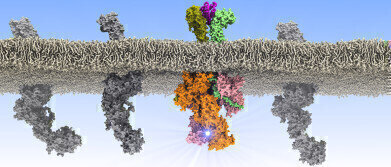-
 Rogue communications in the membrane of blood stem cells. Picture credit: Ilpo Vattulainen and Joni Vuorio from the University of Helsinki.
Rogue communications in the membrane of blood stem cells. Picture credit: Ilpo Vattulainen and Joni Vuorio from the University of Helsinki.
News
Scientists Uncover how changes in Communication Patterns can lead to Leukaemia
Feb 28 2020
An international team of scientists, including researchers at the University of York, have discovered how blood cells can deviate from their normal method of communicating with each other, prompting the development of blood cells to spiral out of control, such as in the case of Leukaemia.
Using super-resolution fluorescent microscopy, the researchers observed in real time how cells receive instructions from ‘signalling proteins’, which bind to a receptor on the surface of another cell before transmitting a signal telling the cell how to behave.
Blood stem cells communicate via cytokines, which are one of the largest and most diverse families of signalling proteins and are critical for the development of blood cells and the immune system.
Understanding this process led researchers to the discovery that mutations associated with certain types of blood cancers can cause blood stem cells to ‘go rogue’ and communicate without cytokines.
The stem cells begin to transmit uncontrolled signals causing the normal system of blood cell development to become overrun, producing an imbalance of healthy white and red blood cells and platelets.
Professor Ian Hitchcock from the York Biomedical Research Institute and the Department of Biology at the University of York, said: “Our bodies produce billions of blood cells every day via a process of cells signalling between each other. Cytokines act like a factory supervisor, tightly regulating this process and controlling the development and proliferation of the different blood cell types.
“Our observations led us to a previously unknown mechanism for how individual mutations trigger blood stem cells to start signalling independently of cytokines, causing the normal system to become out of control and leading to diseases like leukaemia.
“Understanding this mechanism may enable the identification of targets for the development of new drugs.”
This research team used a combination of molecular modelling, structural biology, biophysics, super-resolution microscopy and cell biology to demonstrate for the first time that these specific receptors on the surface of blood stem cells are linked by cytokines to form pairs.
Co-author of the study, Professor Jacob Piehler from Osnabrück University, said: “By directly visualising individual receptors at physiological conditions under the microscope, we were able to resolve a controversy that has preoccupied the field for more than 20 years."
Professor Ilpo Vattulainen from the University of Helsinki, added: “Our biomolecular simulations unveiled surprising features concerning the orientation of active receptor pairs at the plasma membrane, explaining how mutations render activation possible without a ligand (such as a cytokine). These predictions were subsequently confirmed experimentally."
First author Dr. Stephan Wilmes, who started the project as a Postdoc at Osnabrück University before moving to the University of Dundee: “It was truly inspiring to tackle this highly relevant biomedical question by applying cutting-edge biophysical techniques. Here in Dundee, I had the chance to perform complementary activity assays, which corroborated our mechanistic model.”
Digital Edition
Lab Asia Dec 2025
December 2025
Chromatography Articles- Cutting-edge sample preparation tools help laboratories to stay ahead of the curveMass Spectrometry & Spectroscopy Articles- Unlocking the complexity of metabolomics: Pushi...
View all digital editions
Events
Jan 21 2026 Tokyo, Japan
Jan 28 2026 Tokyo, Japan
Jan 29 2026 New Delhi, India
Feb 07 2026 Boston, MA, USA
Asia Pharma Expo/Asia Lab Expo
Feb 12 2026 Dhaka, Bangladesh


















